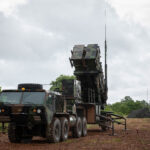A snapshot of recent news from sources around the world on the ongoing Russia-Ukraine war.

Patriot Missile System. Image: U.S. Army/ Sgt. Alexandra Shea
Political Developments
The U.S. has said it is prepared to train additional Ukrainian soldiers if needed. There are currently U.S. advisors in Ukraine, but training of Ukrainian soldiers is currently taking place outside of the country. It remains to be seen if training programs would be established inside Ukraine. At the same time, the Ukrainian military is facing recruiting challenges. Kyiv recently lowered its conscription age from 27 to 25 to increase the pool of recruits, and the government is also putting pressure on conscription-age men outside of the country to return to Ukraine.
Russia opened a display of captured military equipment in Moscow on May 1. The exhibition includes armored vehicles provided to Ukraine from a number of sources. One of the vehicles on display, a British-supplied Alvis 4, was misidentified as a South African Mamba.
President Zelensky dismissed the head of the Security Service of Ukraine’s cybersecurity department, following an investigation into his finances.
Military Assistance to Ukraine
The $61 billion aid package recently adopted in the U.S. is expected to last through the end of calendar year 2024, according to National Security Advisor Jake Sullivan (the U.S. fiscal year ends September 30). Sullivan also confirmed that a “significant” number of Army Tactical Missile Systems (ATACMS) were shipped to Ukraine in March and are now operational on the battlefield.
Australia announced a AUD100 million ($65 million) aid package to buy military supplies for Ukraine. The aid includes AUD50 million ($32.5 million) for short-range air defense equipment, AUD30 million ($19.5 million) for drones, and AUD15 million ($9.8 million) for smaller items like inflatable boats, helmets, boots, masks, and generators. The funding brings Australia’s total commitment to Ukraine to AUD880 million ($571.9 million) since Mosco invaded in 2022. Australia’s previous donations include 120 Bushmaster armored vehicles, 56 M113 armored vehicles, six howitzers, and 14 special operations vehicles.
The Spanish government plans to send Patriot air defense missiles to Ukriane. Madrid will not provide launchers to the Ukrainian military.
Italy has delivered Storm Shadow cruise missiles to Ukraine. This information is revealed by British Defense Secretary Grant Shapps during a press interview.
Berlin has delivered over 10 Marder infantry fighting vehicles, a Skynex air-defense system, tank ammunition, and IRIS-T SLM missiles to Ukraine, according to a statement published on April 29.
The United States plans to put a rush on the delivery of Patriot surface-to-air missiles (SAMs) to Ukraine. Kyiv has told its Western allies that it is running out of missiles to defend itself from Russian aerial attacks.
Some Israeli citizens have petitioned their government to transfer recently-retired Patriot systems to Ukraine.
The UK is open to sourcing drone components from China for Ukraine, according to a government official. This approach would go against the U.S. approach, which focuses on sourcing from Western companies and avoiding Chinese parts. Sourcing components from China could reduce some costs associated with unmanned systems donations. Both Western and Chinese drones have been taken down by Russian electronic warfare operations.
Battlefield Updates
The Ukrainian military has released an estimate of Russia’s missile stockpile. The Russian military has 400 Onyx, 270 Kalibr and 45 Kh-69 cruise missiles. Moscow also has about 40 Zircon missiles.
Pieces of North Korean-made ballistic missiles were discovered in Ukraine. Pyongyang reportedly sold Hwasong 11 ballistic missiles to Russia. The wreckage was found in Kharkiv after a Russian attack on the city in early January.
Open source intelligence indicates that Russia is building a new airbase in Belgorod Oblast, which borders Ukraine.
China’s supply of dual-use components (i.e. parts that can serve both a public and military use) to Russia has been one of the driving factors in Moscow’s recent successes on the battlefield, according to U.S. intelligence. Chinese goods are also helping Moscow to rebuild its military strength after losing much of its equipment in the early stages of the invasion.
